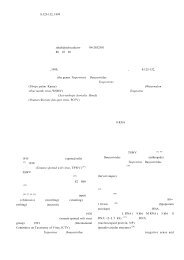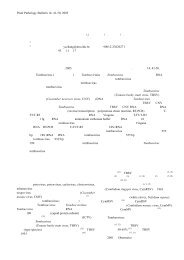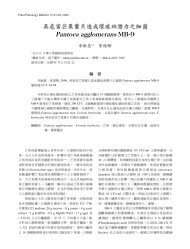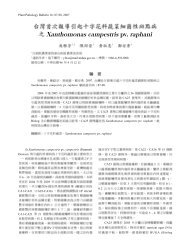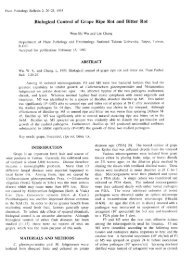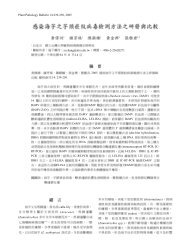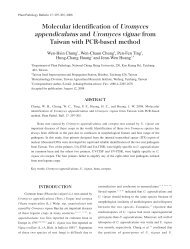1 4 4Plant Pathology Bullet<strong>in</strong> Vol.7(3) 1998<strong>cultivation</strong> <strong>sites</strong>): Taipei Metropolis, Ma<strong>in</strong> campus of theNational Taiwan University, 12 V 1993, on bark of M e l a l e u c al e u c a d e n d r a, W. C. Leong 11; d i t t o except collected 22 VII1996, C.-H. Chung M1294; 15 VI 1993, on dead bark ofC ryptomeria japonica, C. P. Chang 19; Taipei County,between Shihmen and K<strong>in</strong>shan, 28 X 1995, on dead woodalong the seashore, C.-H. Chung M922.P h y s a rum nutans P e r s o o nSpecimen exam<strong>in</strong>ed: Nantou County, Apr. 8, 1981, ondead wood, Liu CHLM285.P h y s a rum rigidum (G. Lister) G. ListerSpecimen exam<strong>in</strong>ed: Hs<strong>in</strong>chu County, Nov. 30, 1980, onplastic bags used for cultivat<strong>in</strong>g A u r i c u l a r i a, Liu CHLM52;Nantou County, Apr. 8, 1981, on dead wood, Liu CHLM310.*P h y s a rum viride (Bulliard) PersoonSpecimen exam<strong>in</strong>ed: Nantou County, Apr. 8, 1981, ondead wood, Liu CHLM289.S T E M O N I TA L E SCollaria ar c y r i o n e m a (Rostaf<strong>in</strong>ski) Nannenga-Bremekamp e x L a d oSpecimen exam<strong>in</strong>ed: Hs<strong>in</strong>chu County, Sep. 4, 1980, ondead wood, Liu CHLM107.Stemonaria longa (Peck) Nannenga-Bremekamp, R.Sharma & Y. Ya m a m o t oSpecimen exam<strong>in</strong>ed: Taipei County, Feb. 26, 1980, ondead wood, Liu CHLM80; Nantou County, Sep. 15, 1980, ondead wood, Liu CHLM128; Ta<strong>in</strong>an City, Aug. 4, 1986, ondead wood, Liu CHLB603.S t e m o n i t i s a x i f e r a (Bulliard) T. Macbride var. a x i f e r aSpecimen exam<strong>in</strong>ed: Nantou County, Apr. 8, 1981, ondead wood, Liu CHLM348.*S t e m o n i t i s a x i f e r a v a r. s m i t h i i ( T. Macbride) Hagelste<strong>in</strong>Specimen exam<strong>in</strong>ed: Taipei Metropolis, Mar. 16, 1988,on dead wood, Liu CHLB790a; Taipei County, Oct. 18, 1984,on dead wood, Liu CHLB425; Hs<strong>in</strong>chu County, Sep. 4, 1980,on dead wood, Liu CHLM108.S t e m o n i t i s f u s c a Roth var. f u s c aSpecimen exam<strong>in</strong>ed: Nantou County, Oct. 26, 1981, ondead wood, Liu CHLM386; Ta<strong>in</strong>an City, Aug. 4, 1986, ondead wood, Liu CHLB621.*S t e m o n i t i s f u s c a v a r. n i g re s c e n s (Rex) To r r e n dSpecimen exam<strong>in</strong>ed: Hs<strong>in</strong>chu County, Feb. 11, 1981, ondead wood, Liu CHLM192; Nantou County, Apr. 7, 1981, ondead bark, Liu CHLM209; Ta<strong>in</strong>an City, Aug. 4, 1986, deadwood, Liu CHLB619.*S t e m o n i t i s f u s c a v a r. p a p i l l o s a M e y l a nSpecimen exam<strong>in</strong>ed: Nantou County, Nov. 19, 1980, ondead wood, Liu CHLM167.S t e m o n i t i s h e r b a t i c a P e c kSpecimen exam<strong>in</strong>ed: Taipei County, Oct. 18, 1984, ondead wood, Liu CHLB424; Hs<strong>in</strong>chu County, Jun. 11, 1980,on plant debris, Liu CHLM75; Nantou County, Nov. 19, 1980,on dead wood, Liu CHLM77.**Stemonitis splendens R o s t a f i n s k iSpecimen exam<strong>in</strong>ed: Taipei Metropolis, Mar. 16, 1988,on dead bark, Liu CHLB786; Hs<strong>in</strong>chu County, Sep. 15, 1980,on dead wood, Liu CHLM124; Nantou County, Nov. 14,1983, on dead wood, Liu CHLB339.Notes: Liao (13) has reported this species as pathogenicto Lent<strong>in</strong>ula edodes.*S t e m o n i t i s v i rg i n i e n s i s R e xSpecimen exam<strong>in</strong>ed: Hs<strong>in</strong>chu County, Sep. 4, 1980, ondead wood, Liu CHLM106.*Stemonitopsis hypero p t a (Meylan) Nannenga-B r e m e k a m pSpecimen exam<strong>in</strong>ed: Taipei Metropolis, Mar. 16, 1988,on dead wood, Liu CHLB790b; Nantou County, Nov. 14,1983, on dead wood, Liu CHLM337.*Stemonitopsis typh<strong>in</strong>a ( Wiggers) Nannenga-B r e m e k a m pSpecimen exam<strong>in</strong>ed: Taipei County, Oct. 18, 1984, ondead bark, Liu CHLB422.D I S C U S S I O NTrue slime <strong>molds</strong> are well known to be culturedaxenically for experimental biology <strong>in</strong> recent decades, butHoward (6) and Lister (16) have raised these organisms byfresh <strong>mushroom</strong>s <strong>in</strong> earlier times. Howard and Currie (8) andHoward (7) made scrut<strong>in</strong>ous observations and sophisticatedexperiments on the mycophagy of slime <strong>molds</strong>. A total oftwenty-three mycophagous taxa were proposed by them, ofwhich eleven species are also observed from <strong>mushroom</strong><strong>cultivation</strong> <strong>sites</strong> <strong>in</strong> this communication.Analysis of the species diversity of slime <strong>molds</strong> found <strong>in</strong>this study at the level of order (Fig. 5) reveals that thediversity of the Stemonitales is the highest, follow<strong>in</strong>g by theTrichiales. It is generally recognized that taxa of Physaraleson litter are the major components of the tropicalmyxomycete biota, but taxa of Stemonitales and Tr i c h i a l e sare better known from dead wood (23). Rationally, these twoorders are dom<strong>in</strong>ant <strong>in</strong> <strong>mushroom</strong> <strong>cultivation</strong> <strong>sites</strong>, whereconsiderable amount of logs were used as substrates. On the
<strong>Slime</strong> <strong>molds</strong> <strong>in</strong> <strong>edible</strong> <strong>mushroom</strong> <strong>cultivation</strong> <strong>sites</strong> 1 4 5Fig 5. The relative frequency of different orders of slime<strong>molds</strong> recorded from <strong>mushroom</strong> <strong>cultivation</strong> <strong>sites</strong> <strong>in</strong> Taiwan.other hand, taxa with m<strong>in</strong>ute sporocarps, e. g. Licea a n dspecies of Ech<strong>in</strong>osteliales, tend to be overlooked <strong>in</strong> the dimlight of <strong>mushroom</strong> <strong>cultivation</strong> <strong>sites</strong>. Studies us<strong>in</strong>g moistchamber culture techniques might make up the deficency.Liao noted that <strong>in</strong>fection rate of slime <strong>molds</strong> was lowerwhen hardwood, e. g. Castanopsis formosana, was used forgrow<strong>in</strong>g Lent<strong>in</strong>ula edodes (13). More sporocarps ofS t e m o n i t i s were observed on softwood, e. g. Hibiscust i l i a c e o u s, blue Japanese oak, and red ch<strong>in</strong>k p<strong>in</strong>, <strong>in</strong> his study.H o w e v e r, these observations need verification, and it wouldbe <strong>in</strong>trigu<strong>in</strong>g to study whether some other tree species aremore resistant to slime <strong>molds</strong> colonization.Although all of the the slime <strong>molds</strong> reported <strong>in</strong> thiscommunication are commonly encountered <strong>in</strong> the field, about50% (sixteen out of thirty-three taxa) of the taxa reportedwere not known from <strong>mushroom</strong> <strong>cultivation</strong> <strong>sites</strong> prior to thiss t u d y. The paucity of our knowledge on myxomycete biota <strong>in</strong>such habitat is probably resulted from the fact that thetaxonomic hierarchy was largely based on characters ofsporocarps. This makes it extremely difficult to identify the<strong>mushroom</strong>-forag<strong>in</strong>g plasmodial stage of Myxomycetes if nofruit<strong>in</strong>g body forms. In fact, although it is easy to grow theplasmodia <strong>in</strong> vitro for several years, the plasmodia frequentlyfailed to form fruit<strong>in</strong>g bodies (Chung, pers. observ.). In thefuture, it would be <strong>in</strong>terest<strong>in</strong>g to characterize or even toidentify the Myxomycetes without sporocarps. Specimenscited <strong>in</strong> this communication have been stored <strong>in</strong> herbarium foryears for taxonomic purposes and are not suitable for cultures t u d i e s .Myxomycetes may not only affect growth of <strong>mushroom</strong>sby caus<strong>in</strong>g diseases but also function as weeds. Liao (13)regarded the slime <strong>molds</strong> as competitor of space and nutrition,and the logs <strong>in</strong>oculated with spores of S t e m o n i t i s a l m o s tcompletely devoid of <strong>mushroom</strong> fruit<strong>in</strong>g. Several notoriouspathogenic species <strong>in</strong> <strong>mushroom</strong> farms, such as Ve rt i c i l l i u mf u n g i c o l a and Aphanocladium album, were found associatedwith fruit<strong>in</strong>g bodies of Myxomycetes (22). Therefore moldedfruit<strong>in</strong>g bodies of Myxomycetes may serve as a temporalreservoir of <strong>mushroom</strong>-pathogenic fungi. However, due to thelack of adequate knowledge, it is premature to draw anyconclusion at this stage for the nature of the association ofslime <strong>molds</strong> and cultivated <strong>mushroom</strong>s and the total effect ofthis association on <strong>mushroom</strong> <strong>cultivation</strong>.Currently there is no effective method available forcontrol of slime <strong>molds</strong> <strong>in</strong> the <strong>mushroom</strong> <strong>cultivation</strong> <strong>sites</strong>. Atpresent, remedies <strong>in</strong>clud<strong>in</strong>g reduction of water supply andremoval of plasmodia and young sporocarps by physicalmeans has been suggested (19, 24). Harada (5) applied tablesalt to elim<strong>in</strong>ate plasmodia, and Chen (2) wiped out the slime<strong>molds</strong> grow<strong>in</strong>g on the surface of plastic conta<strong>in</strong>ers with clothwetted with gasol<strong>in</strong>e. Both apporaches require not onlyenormous labors, also the residual gasol<strong>in</strong>e may pose apossible risk of fire outbreak. In addition, the toxic additivesof gasol<strong>in</strong>e, i. e. lead, may be absorbed by the <strong>mushroom</strong>s andenter human bodies when consumed. Salt<strong>in</strong>g may also<strong>in</strong>crease the liberation of conidia of fungal pathogens, i. e.( 1 ).A C K N O W L E D G E M E N T SWe appreciate Dr. Fransisco Pando de la Hoz, RealJard<strong>in</strong> Botanico, CISC, Spa<strong>in</strong>, for <strong>in</strong>valuable comments. Mr.W. C. Leong and Mr. C. P. Chang, both Department ofB o t a n y, National Taiwan University, are thanked forcontribut<strong>in</strong>g their specimens of F u l i g o for study.L I T E R ATURE CITED1 . Adie, B. A. T., Muthumeenaksi, S., Grogan, H. M., Mills,P. R. and Archer, S. 1998. The taxonomy, biology andepidemiology of cobweb caus<strong>in</strong>g pathogens, primarilyC l a d o b o t ryum dendro i d e s. 7th International Congress ofPlant Pathology, August 9-16, 1998, Ed<strong>in</strong>burgh, Scotland.2 . Chen, C.-S. 1994. Water management on G a n o d e r m afruit<strong>in</strong>g body production and gasol<strong>in</strong>e to control slmemold. J. Agric. Assoc. Ch<strong>in</strong>a, New Ser. (168): 85-92. (InCh<strong>in</strong>ese with English abstract)3 . Cheng, S. 1987. Wood ear. pages 1055-1058 <strong>in</strong>: Ta i w a nAgricultural Encyclopedia, 4 ed. Coun. Agric. ed., Ta i p e i ,



